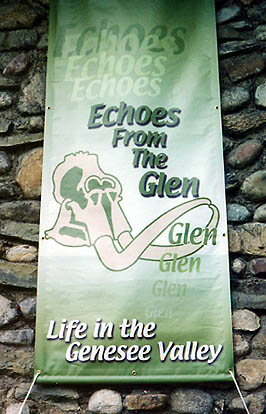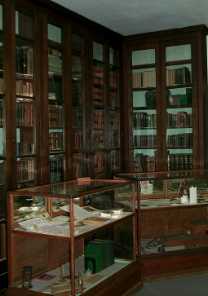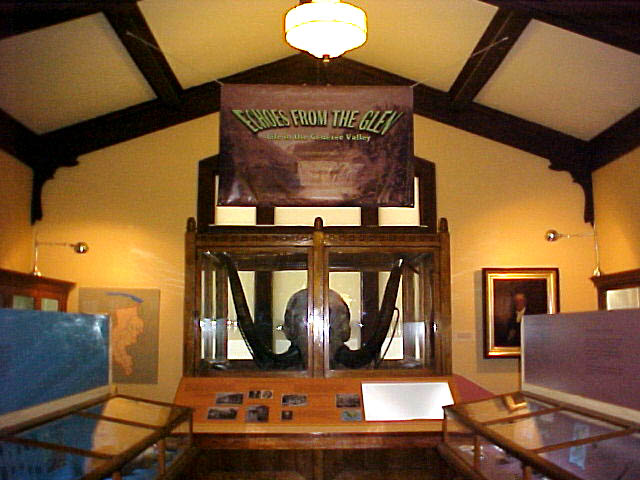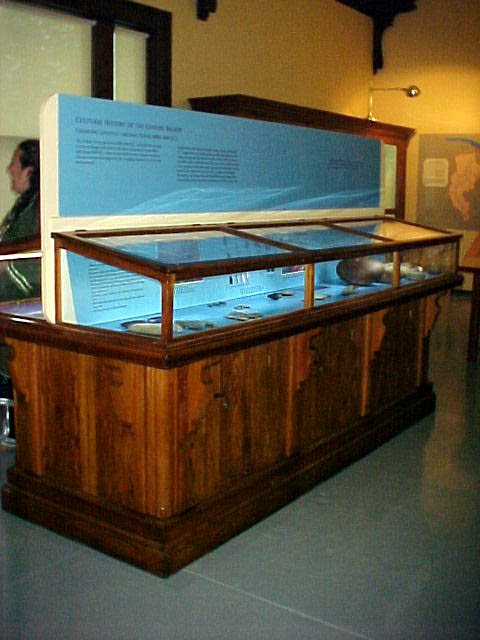Glimpses of the Past
People, Places, and Things in Letchworth Park History
 |
Wm P. Letchworth Museum |
 |
|
Preservation was always an important goal of William Pryor Letchworth. Just as he hoped that his Glen Iris Estate would protect the natural beauty of the Portage Falls area, Mr. Letchworth also tirelessly worked to preserve the Valley's long and rich heritage. As one of the founders of the Buffalo Historical Society, Letchworth developed a deep interest in the first people to live in Western New York. By 1871 he was making expeditions to early sites with other "gentlemen archaeologists", and building a collection of native artifacts. These studies led to his purchase of the Caneadea Council House, the Nancy Jemison Cabin, and creating the Mary Jemison Memorial area with her grave and statue which constitute the Council Grounds on a bluff above his beloved Glen Iris in the present day park. At first Mr. Letchworth kept his growing collection in the Council House and adjacent buildings. Concerned for the safety and security of the artifacts, he built the fireproof Genesee Valley Museum in 1898. According to the official guide, the new museum would be " a depository for archaeological relics that shall serve to illustrate the primitive arts of the North American Indians, and especially for the safe preservation of everything relating to the aboriginal occupation of western New York and to the history of the Genesee Valley and its vicinity during the days of its Indian ownership." (Guide, p1) (see original Museum photograph) The Genesee Valley Museum, as well as the rest of the Council Grounds, was included in the gift of the Glen Iris Estate to New York State in 1907. The Museum attracted the immediate attention of the American Scenic and Historic Preservation Society, caretakers of the new Park. In a report entitled "The Educational Possibilities of Letchworth Park," ASHPS member George Kunz summarized the value of the Museum. "Mr. Letchworth already has on his Council House Grounds a small fire-proof museum containing a fine fossil mastodon head exhumed in the neighboring village of Pike; a collection of Indian relics, and some geological specimens. This collection is susceptible of enlargement, not only by the models already suggested (these were geological models of the gorge and region), but in other ways which will increase its usefulness." Kunz also hinted that major changes were in the wind. "If suitable provision can be made for their care, Mr. Letchworth will probably add to his gift his personal library and mementos. The library embraces one of the finest, if not the finest, private collection of book on charities in the country. It contains also a good collection of local histories, books about Indians, and a miscellaneous assortment of standard literature. His mementos - personal gifts and testimonials - are extremely interesting. It is most desirable that these should be kept together and adequately preserved in a new library building, as part of the monument to the generous donor of Letchworth Park." (12th Annual Report, 1907 p192,193) The two ideas - the enlargement of the museum collection, and "suitable provisions" for Letchworth's personal library came together when plans were laid for a new library building to be built near the Glen Iris. Ground was broken for the project in September of 1912, almost two years after Mr. Letchworth's death. The work was not without controversy, for the location chosen for the library was the site of the formal Glen Iris flower gardens. (see photograph of gardens) The library was made of hollow tile, faced with stone and "rubble" from the Portage gorge and was completed in 1913 at a cost of nearly $10,000, a sum Mr. Letchworth had left for that very purpose. Extensive changes were then made on the Council Ground, including the demolition of the Genesee Valley Museum and moving the mastodon skull and the other artifacts to the library building. (see photograph of construction work) These changes were difficult for many who had visited Mr. Letchworth at the Glen Iris. Wolcott J. Humphrey, in an address to the newly formed William Pryor Letchworth Memorial Association, stated that many of his good friends "were nearly in tears when the garden with its protecting hedge was removed" and that "the appearance of the Council House grounds after the demolition of the cottage there situated, the removal of the fence and the cutting down of the grove struck me as a blow, and I felt a sense of almost personal anger." But, Humphrey admitted, "the transition of a property such as this from conditions obtaining under the ownership of a man of so courtly hospitality, yet so reserved withal, as Mr. Letchworth, to those necessary to a state park, can not be other than painful to those of us to whom any change in an already beautiful place seems ruthless.... (The) garden was a beautiful and fitting supplement to a gentleman's private house, stable and grounds, but would not be to the house enlarged for the entertainment of ourselves and other lovers of the beautiful; and would certainly have no value as an offset to the library and museum building." As to the changes in the Council Grounds, Humphrey stated that he is "not so rash as to say that even now anyone would wish the grounds as they were, to say nothing of the vastly improved garb they will wear a year from now." (Memorial Association, 1915, p 12) (see 1914 photograph) Memories of what had been faded as a new generation of tourists flocked to visit the Park. It wasn't long before the "Letchworth Park Museum" became one of the highlights of a visit to Letchworth. (see 1920's photograph). Over the next
few decades the Museum grew in several ways. In the late 1920's,
the Seneca archaeologist, Arthur Parker, did extensive work on
the native collections and exhibits. Parker also arranged for
the loan of additional artifacts from the Rochester Museum and
Science Center, including fine example of Iroquois Craft The next major developments in the Museum's history took place in the 1970's. First, a team of State museum specialists arrived at the Park to begin the work of preserving the extensive holdings of the Museum and improving the interpretive aspects of the displays. Most of their limited time was spent in the conservation of collections, including the inventory, fumigation and careful storage in "acid free" containers, assuring that the Museum's treasures would be available for future generations to enjoy. This work was followed up by the creation of the Letchworth Park History Program 1978, which continued the care of the collection as well as improving the interpretive displays. The Program also began a variety of history related talks, tours, and events, which added to the visitors enjoyment of the past. The 80's and 90's brought additional changes. Physical improvements to the building were carried out, including insulation, improved heating and ventilating, handicapped access, and a protective alarm system. A statewide recognition of our Historic value led to the establishment of a full time Historic Site Manager at the Park. A state level bureau controls historic properties so the Park has a staff at Peebles Island to call upon for technical assistance. |
|
Photos by Tom Cook May 2000 These photos show the Museum before the current renovation. Above is the Pike Mastodon, that Mr. Letchworth first exhibited on the Council Grounds. At right is part of Mr. Letchworth's personal library and artifacts related to his life and work. |
Many people were confused when the Association asked for the return of their property to be housed in a building at Silver Lake near the Pioneer Cabin. After much study, this was done in the mid 1990's and a general rearranging of the museum exhibits took place at that time. Also at about the same time the Letchworth papers and library were returned to the Park from Geneseo State University. The stage was now set for new chapter in the Museum's history. Plans were laid for a major renovation and rededication of the facility in honor of Letchworth Park's Centennial Celebration. |
 |
|
The work on the "new" museum was carried out by a team which included the museum professionals from Peebles Island, Letchworth's own talented history staff, other Park workers such as painters and carpenters, and a variety of outside historians and experts. A complete environmental system was installed to protect the artifacts during winter cold and summer humidity, and the storage facilities and security system were upgraded. The two main display rooms underwent a complete make over. The northern room, which had been known as the "Indian Room" is now a display that tells the story of William P Letchworth, while the southern display room, which utilizes many of the display cases and artifacts from the original Genesee Valley Museum,  |
Above: Entrance to the new display on the life and times of Wm P Letchworth; Left: part of the new display room which documents the history of the Genesee Valley and the lives of the many groups of people who have lived here. The "Echoes from the Glen" includes the story of the Seneca, Mary Jemison, the Genesee Valley Canal, Portage Bridge, and much more. Photos by Tom Cook May 2006 |
|
The William Pryor Museum was rededicated during the Centennial ceremonies held on May 26, 2006. The ceremonies began on the lawn of the Glen Iris. They speeches by State, Local, and Park officials, as well as recognition of representatives of the Letchworth family and descendants of Mary Jemison who were in attendance. The speeches were followed by a ribbon cutting which marked the official grand re-opening of the Museum. (The photograph to the right shows the ribbon cutting - from left to right is Brian Scriven, Letchworth Park Historic Site Manager; Ed Rutkowski, Western District Director of Parks and Historic Sites; State Assemblyman Dan Burling; William Pryor Letchworth (portrayed by a local actor); Genesee State Park Commission Chairman Peter Humphrey; and NY State Deputy Parks Commissioner Dominic Jacangelo. |
|
Today, the "new" William Pryor Letchworth Museum at Letchworth Park continues to be a door into the fascinating history of Letchworth Park and a tribute to the efforts of Mr. Letchworth to preserve that past for all to share and enjoy. |
 |
Left: One of Mr. Letchworth's original museum cases refurbished by Park staff and incorporated into the Echoes of the Glen exhibit on the Genesee Valley. Right: You never know who you might meet in the Museum - here is Mr. Letchworth and a traveling minstrel studying photographs from the Glen Iris that are on view in the "Man Who Always Does Right" exhibit. (Mr. Letchworth was portrayed by local actor)
photographs by Tom Cook |
|
Tom
Breslin
Tom
Cook
Sources
ASHPS, Annual Report 1907, 192-193
Minutes.... pp 12